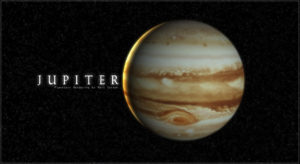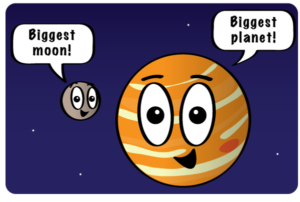Jupiter The Planet
Jupiter, the largest planet in our solar system, is appropriately named after the King of the Ancient Roman gods. This giant fifth planet from the sun fits 11 Earths across its disc. Hydrogen and Helium comprises most of Jupiter’s atmosphere, transforming to liquid metallic hydrogen at lower altitudes. Some speculate there may be a solid core about the size of our Earth at its center, but the truth is unknown. Violent turbulence dominates the atmosphere, the iconic Giant Red Spot being an example of a storm persisting for centuries. That familiar feature is larger than Earth.
A major system of satellites also accompany the gas giant. In 1610, Galileo discovered Jupiter’s four largest moons, Callisto, Ganymede, Io, and Europa. More than 50 named moons are now known to orbit the planet and 16 provisional moons discovered but have not been named or giving official status. One of Jupiter’s moons, Ganymede is the largest in the solar system, even larger in diameter than the planet Mercury and dwarf planet Pluto. Three faint rings were revealed by NASA’s Voyager missions. The Juno spacecraft currently orbits Jupiter.
Life There
The possibility of life became a reality on some of Jupiter’s moons with the discovery of vast water oceans beneath thick shells of ice. But what of Jupiter itself? “Highly unlikely” is the general consensus. Although the building blocks of life are present in Jupiter’s atmosphere at some altitudes, including water vapor clouds, there is such turbulence it is difficult to imagine stable enough conditions for life to arise. But…life persists in areas on Earth with conditions that seem quite impossible, but yet there it is. Although a quote from science fiction, there is plausibility. “Life will find a way.”
The post Jupiter The Planet appeared first on R. A. Andrade.






